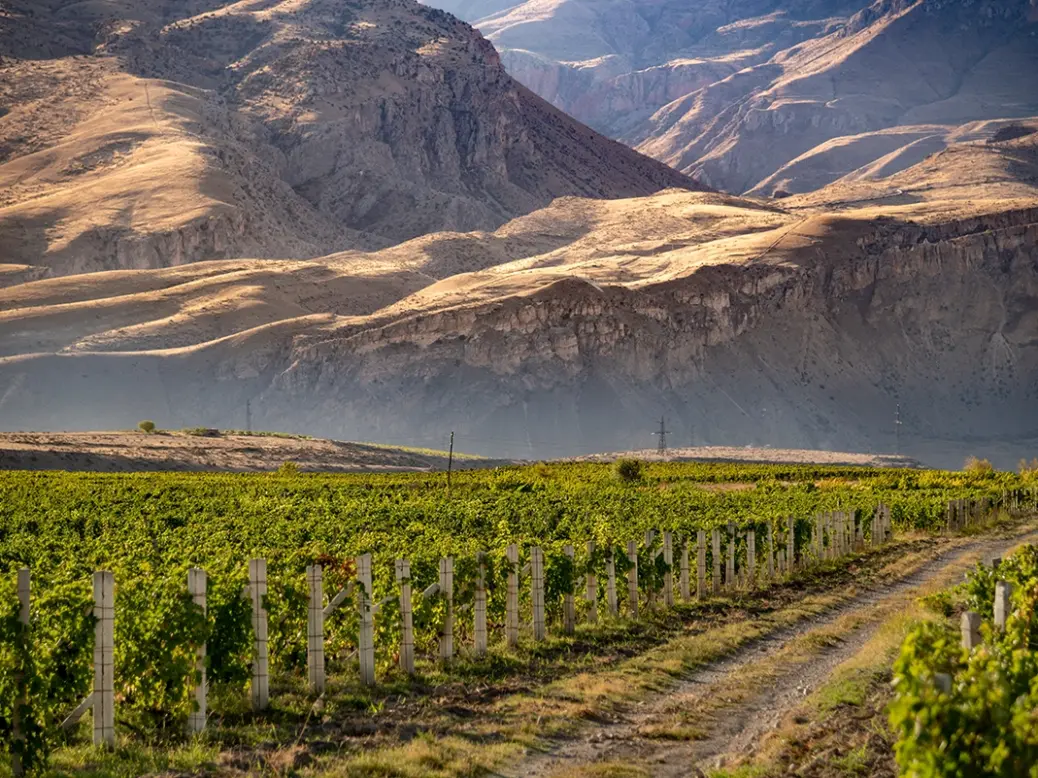
The oldest known winery in the world, dating to approximately 4,000 BC, lies inside a cave in Armenia, a couple hours’ drive east of Mt. Ararat, where Noah famously parked the Ark. Which seems appropriate enough, given that Noah’s very next act was to plant vines to grow wine grapes. It’s equally fitting in the context of Armenia’s contemporary wine scene, since the cave is in the heart of Vayots Dzor, home to the country’s most exciting vineyards.
Armenian wines have been slower to emerge on the international scene than than those produced in the country’s northern neighbor, Georgia, but both share a multi-millennial history of winemaking and a bevy of indigenous grape varieties. Georgia’s amber qvevri wines captured the attention of sommeliers over a decade ago, when Georgians discovered their traditional Russian market could be a difficult customer. Armenia’s relationship with Russia has been less strained, so there’s been less pressure to cultivate Western markets.
Going back further, Soviet central planning had designated Georgia a wine-producing area while earmarking Armenia for brandy instead, a decision that led to the extensive planting of newer crosses and hybrids suited for distillation. The province of Vayots Dzor was spared this fate at least in part thanks to its remoteness and elevation. The lowest point in the Areni valley at the center of the province lies at 850m (2,790ft) elevation, and vineyards stretch up to 1,750 meters—over a mile (5,740ft). These remarkable altitudes create hot, arid conditions in the summer, tempered by cooler nights, and bitterly cold winters; burying vines to protect them from the cold is a usual practice. Soils in the region are a mix of volcanic rock and limestone.
The cold winters and isolation have also protected Vayots Dzor from phylloxera, and all the provinces’ vineyards are planted on their own roots—grafting is in fact illegal. Many of the vines are exceptionally old, some even pre-dating the Soviet era; the relatively small size of their trunks speaks to the tough conditions they’ve endured. Keush, one of the leading producers in the area, sources from one such vineyard on the border with Azerbaijan with 130-year-old vines, and vines with 50-60 years of age are not uncommon. Bush vines are the norms for the oldest vineyards, whereas those from the Soviet era are typically trellised.
Vayots Dzor: Renewed pride
Vayots Dzor touches the Azerbaijani border on two sides, and the founder of Keush, Vahe Keushguerian, says the conflict between Armenia and Azerbaijan in 2020, during which many of the farmers stayed and helped defend their land, has created a renewed pride among the region’s grape growers. A number of abandoned vineyards have been revitalized, but grape sourcing is still challenging. “Many farmers don’t care who they sell their grapes to,” Keushguerian says. “It’s first come, first served,” at the time of harvest, with few long-term contracts and the ever-present chance that organized crime will step in and demand its cut. Keushguerian says some vineyards even require armed guards as harvest approaches. He and other producers investing in the region are planting their own vineyards to establish better control of their raw materials.
Keush makes traditional method sparkling wines, and Keushguerian also makes a few still wines under the Oshin brand; his daughter Aimee launched her Zulal brand in 2017, sourcing grapes from not just Vayots Dzor but across Armenia. More usually traffic in grapes goes in the other direction, with producers from all across Armenia sourcing grapes from the province, despite its relatively modest hectarage—1,214ha (3,000 acres), compared to 6,924ha (17,110 acres) in Armavir, the province with the most plantings in the country.
The grape producers come for in particular is Areni—it’s the country’s best variety, and Vayots Dzor seems to be both its birthplace and the region best suited to the grape. Californian Paul Hobbs chose the region and the variety for his partnership, Yacoubian-Hobbs. Voskevaz, located west of Armenia’s capital Yerevan, makes one of the country’s few amphora-aged examples; in another contrast with Georgia, the clay vessels, locally called “karas,” are no longer being produced, though they have a similar history in Armenia.
Areni typically yields a firm, red-fruit wine, structured but not overly tannic despite its thick skins, and comparable in style to Chilean or South African Cinsault or brighter, less-extracted renditions of Grenache. The smoky, mineral note often associated with volcanic soils comes through in the better examples as well. It’s capable of great depth of flavor without over-extraction or heaviness, and the few older examples I’ve had the chance to sample had taken on tertiary notes reminiscent to those of an aged Chianti Classico.
Among the white grapes, Voskehat also does very well in the province. The grape comes with a certain weight and texture, but the best examples avoid the broad or oily character that leads some to compare it to Viognier; the cooler conditions in Vayots Dzor support that more focused expression. Khatouni is also grown in the province and often blended with Voskehat for additional aroma and freshness.
While there’s been some local investment in the wine industry, the push currently driving the Armenian wine scene comes from abroad—another contrast with Georgia, where much of the activity is in the hands of home winemakers turned professional. The Armenian diaspora is large, by some estimates numbering as many as seven million people. Much of the investment in the industry comes from this proud community, from individuals who are either returning to Armenia or enthusiastically investing in their homeland. In the past decade the educational opportunities, modern equipment, and market access that community is providing has accelerated Armenia’s vinous development tremendously, and have already made Vayots Dzor a name worth remembering.






